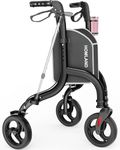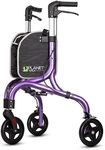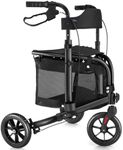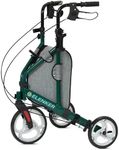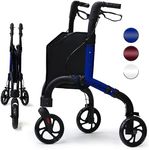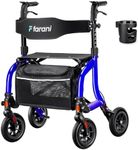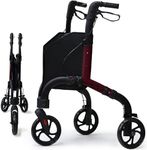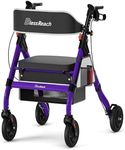Buying Guide for the Best 3 Wheel Walkers
Choosing the right 3-wheel walker can significantly enhance your mobility and independence. These walkers are designed to provide support and stability while being lightweight and easy to maneuver. When selecting a 3-wheel walker, it's important to consider various specifications to ensure it meets your specific needs and preferences. Here are some key specs to look at and how to navigate them to find the best fit for you.Weight CapacityWeight capacity refers to the maximum weight that the walker can safely support. This is important to ensure the walker can handle your body weight without compromising stability or safety. Typically, weight capacities range from 250 to 300 pounds. If you weigh less than 250 pounds, a standard walker will suffice. If you weigh more, look for a walker with a higher weight capacity to ensure durability and safety.
Walker WeightThe weight of the walker itself is crucial for ease of use and transport. Lighter walkers are easier to lift and maneuver, especially if you need to transport it frequently. Walkers generally weigh between 10 to 15 pounds. If you have limited strength or need to carry the walker often, opt for a lighter model. If stability is more important and you don't need to lift it often, a slightly heavier model might be more suitable.
FoldabilityFoldability refers to how easily the walker can be collapsed for storage or transport. This is important for convenience, especially if you have limited space or need to take the walker in a car. Some walkers fold with a simple mechanism, while others may require more effort. If you travel frequently or have limited storage space, look for a walker that folds easily and compactly.
Wheel SizeWheel size affects the walker's maneuverability and ability to handle different terrains. Larger wheels (8 inches or more) provide better stability and can handle rough or uneven surfaces more effectively. Smaller wheels (6 inches or less) are more suitable for indoor use and smooth surfaces. Consider where you will primarily use the walker. For outdoor use or uneven terrain, opt for larger wheels. For indoor use, smaller wheels may be more practical.
Handle Height AdjustabilityAdjustable handle height ensures that the walker can be set to a comfortable level for your height, promoting better posture and reducing strain on your back and arms. Most walkers offer a range of height adjustments. To find the right height, stand upright and let your arms hang naturally at your sides. The handles should be at wrist level. Ensure the walker you choose has a handle height range that accommodates your height.
Braking SystemThe braking system is essential for safety, allowing you to control the walker's movement and stop it when needed. There are different types of brakes, including loop brakes and push-down brakes. Loop brakes are operated by squeezing handles, while push-down brakes engage when you apply downward pressure on the handles. If you have good hand strength and dexterity, loop brakes are effective. If you have limited hand strength, push-down brakes might be easier to use.
Storage OptionsMany 3-wheel walkers come with storage options like baskets, pouches, or trays, which can be useful for carrying personal items, groceries, or medical supplies. Consider what you need to carry regularly and choose a walker with appropriate storage solutions. If you need to carry larger items, look for a walker with a spacious basket or tray. For smaller personal items, a pouch might be sufficient.
